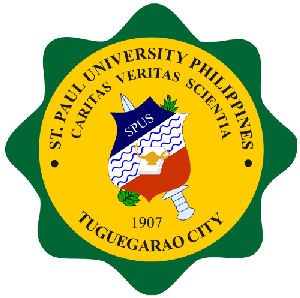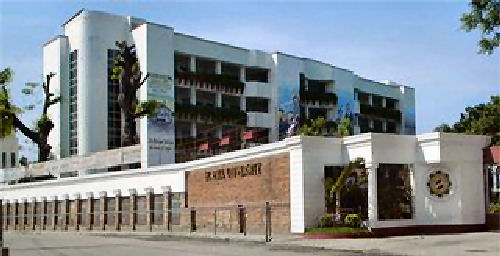 |
St. Paul University Philippines Mabini Street, Tuguegarao City, Cagayan Valley, 3500 Philippines +63 78 846 1863 |
St. Paul University Philippines (SPUP) was founded in 1907 as "Colegio de San Pablo" and is one of 42 schools owned, managed, and operated by the
Sisters of St. Paul of Chartres in the Philippines,
originating in the small village of Levesville-la-Chenard in the diocese of Chartres, northern France, by Father Louis Chauvet, the parish priest, in 1696, with the help of
Mademoiselle Marie Anne de Tilly, who trained the first members. Responding to the appeal of Bishop Frederick Rooker, seven Sisters of St. Paul of Chartres set sail from
Saigon, Vietnam, and arrived in Dumaguete, southern Philippines, in October 1904. The good Bishop counted on them to nurture the faith of the predominantly Catholic population
recently freed from 377 years of Spanish rule, "but which was then prey to ntense proselytizing by American Protestants as well as to the patriotic influences of the
Philippine Independent Church." Starting their missionary work under extreme conditions of poverty and great cultural difficulties, the Sisters proved to be excellent nurses
and educators with the result that other Bishops requested them for other dioceses.
The first Sisters of St. Paul of Chartres in the Philippines opened the first Paulinian School in Dumaguete,
Negros Oriental in 1904. In ten years, they rapidly established 4 Schools and 3 Hospitals including the leper colony in the island of Culion. Within the same period, a Novitiate was
opened in 1913. By 1914, the SPC mission in the Philippines was granted status as a Province. The first Novitiate in Malate, Manila, opened in 1911, was transferred to Quezon City in 1931.
The First Filipina Provincial Superior, Mother Madeleine Denoga was appointed in 1965. The present Provincial Superior is Sr. Zeta Caridad Rivero.
Today, as educators among the many others, 249 Sisters serve more than 59,000 students in 35 schools; 85 Sisters in the Health Ministry serve 63,000 patients in 11 medical institutions;
59 Sisters are full-time pastoral workers, catechizing 78,000 children and adults, caring for street children, lepers, minority tribes, and the poor in the rural and urban areas; and the
91 retired Sisters support the active Sisters spiritually by their prayers and the offering of their pains. 62 Filipina Sisters are missionaries in 13 foreign countries. The year 2004 marks
the Congregationís 100th year of presence and service to the Filipino people. Today, they have 55 houses in 29 dioceses and one house in Bethlehem, Israel.
Today, SPUP is the lead school of six in the St. Paul Philippines System; the others are SPU Quezon City, SPU Manila, SPU Dumagueta, SPU Iloilo, and SPU Surigo. SPUP, the primary university in the northern Philippines, is an ISO Certified Institution recognized as an Autonomous Institution
by the Commission on Higher Education, Center of Excellence in Nursing Education, Center of Development in Teacher Education, Center of Development in Business Education, Center of Development
in Information Technology, Most Outstanding Student Services in the Philippines, Most Environment-Friendly School in Cagayan Valley and a Pontifical Catholic Center for Culture and the Arts.
|
Location: Tuguegarao City in the NE of the main island of the Philippines, 480 km north of Manila (a short 50-minute flight, or a scenic 10-hour bus drive through partly mountenous country),
lies on the 17th parallel north and therefore definitely in the tropics. It is sheltered by the Sierra Madre Mountains in the East, Cordilleras in the West and the Caraballo Mountains in the South.
The community was established by the Dominicans as a mission until the Spaniards gave it the status of pueblo (municipality) in 1604, making it one of the political units of the province of Cagayan.
Tuguegarao was occupied by U.S. troops in December 1899. During World War II, the city and its airfield were captured by the Japanese Imperial Army in December 1941. Today Tuguegarao
is a city of 150,000 people and the capital of the NE Province of Cagayan. |
 St. Paul University Philippines Tuguegarao City by De Los Santos |
|
St. Paul University Philippines |
School of Accountancy and Business |
|
AASBI Accreditation Review Criteria - see Overview GAEP 1 Degree awarding: Yes. 2 Universal Declaration of Human Rights: Two Covenents 1996. 3 Human Rights reflected: Yes.. 4 Equal opportunity: Yes. 5 Infrastructure accessible: Yes. 6 Continued existence: Yes since 1907. 7 Autonomy: Yes. 8 Physical facilities: Yes. 9 Curriculum: Focused. 10 Professional Certification Program: Hospitality: Pending. 11 Student admission: Yes. 12 Teaching effectiveness: Yes. |
13 Faculty qualification: Yes. 14 Faculty teaching load. Yes. 15 Faculty time for leisure: Yes. 16 Faculty development: Yes. 17 Full time and adjunct faculty: No distinction. 18 Faculty association: Pending. 19 Code of conduct: Yes. 20 Reputation or standing: Yes. SPS system. 21 Financial stability: Yes. SPC system. 22 Withdrawal: N.A. 23 Expulsion: N.A. 24 Legal remedy: N.A. 25 Steering committee appointment: Pending. 26 Reimbursements: N.A. |
Updated 2014-02-06
